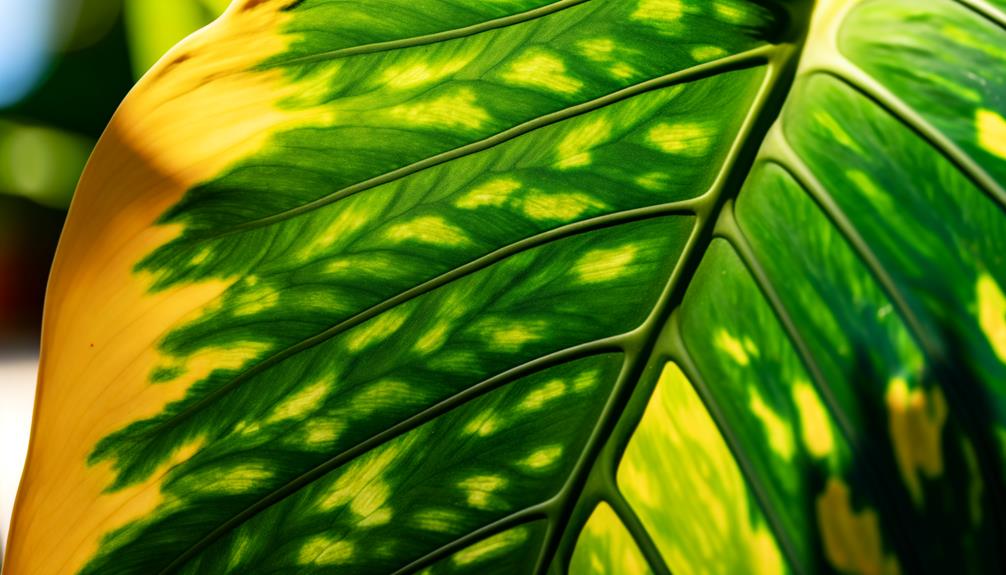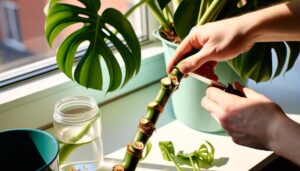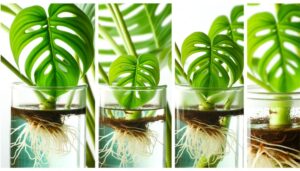Monstera Peru Leaf Turning Yellow
Yellowing leaves on your Monstera Peru indicate underlying issues. Overwatering causes root hypoxia, impairing nutrient uptake.
Guarantee soil moisture levels are adequate and use well-draining soil to prevent waterlogged conditions. Insufficient lighting hinders photosynthesis; position your plant in bright, indirect light.
Nutrient deficiencies, particularly nitrogen, magnesium, or iron, show as yellowing. Check for pests like spider mites and aphids that harm leaves.
Temperature stress from extremes disrupts plant function; maintain 65-80°F. Humidity should be between 60-80%, measured with a hygrometer.
Address these factors diligently, and you'll find solutions to restore your plant's vibrant health.

Key Takeaways
- Overwatering and poor drainage can cause yellowing leaves; ensure soil is well-draining and pots have drainage holes.
- Insufficient lighting hinders photosynthesis; place Monstera Peru in bright, indirect light or use supplemental LED grow lights.
- Nutrient deficiencies, particularly nitrogen, magnesium, or iron, cause yellow leaves; consider using a balanced fertilizer.
- Pest infestations from spider mites, aphids, or thrips can lead to yellowing leaves; regularly check and manage pests appropriately.
- Temperature extremes and insufficient humidity can cause yellowing; maintain a temperature range of 65-80°F and 60-80% relative humidity.
Overwatering Issues
Overwatering is a primary cause of yellowing leaves in Monstera Peru, as it leads to root hypoxia and subsequent nutrient uptake issues. When the soil remains saturated, oxygen availability to the roots diminishes, causing hypoxic conditions. These anaerobic conditions impair the roots' ability to absorb essential nutrients like nitrogen, potassium, and magnesium, leading to chlorosis.
You should monitor soil moisture levels attentively. Use a moisture meter to make certain the substrate is only slightly damp before watering again. Additionally, make sure that you're using a well-aerated substrate to facilitate proper gas exchange. Adjust your watering schedule based on the plant's specific needs, considering environmental factors like humidity and temperature.
Proper hydration management is essential for maintaining healthy, vibrant foliage in your Monstera Peru.
Poor Drainage
Inadequate drainage greatly contributes to yellowing leaves in Monstera Peru by promoting waterlogged conditions that impede root function and nutrient absorption. When the soil remains excessively saturated, root systems suffer from hypoxia, which inhibits their ability to uptake essential minerals and water efficiently.
You should use well-draining soil mixtures, incorporating components like perlite or coarse sand to enhance aeration and prevent compaction. Additionally, make sure your pots have sufficient drainage holes to facilitate excess water expulsion.
Regularly monitor the plant's environment for signs of poor drainage, such as persistent soil moisture or a foul odor indicative of anaerobic bacterial activity. Addressing drainage issues promptly is crucial to maintaining the health and vibrancy of your Monstera Peru.
Insufficient Lighting
Beyond addressing drainage, fundamental to preventing yellowing leaves in Monstera Peru is adequate lighting, as insufficient light can hinder photosynthesis and lead to chlorosis. Place your plant in an area with bright, indirect light, as direct sunlight can cause leaf scorch.
Utilize a light meter to measure the intensity, aiming for a range of 10,000-20,000 lux. If natural light is inadequate, consider supplemental artificial lighting using full-spectrum LED grow lights. Position these lights 12-18 inches above the plant, running them for 12-14 hours daily.
Regularly rotate your Monstera Peru to ensure even light distribution. Monitoring light levels and adjusting as necessary will support optimal chlorophyll production, guaranteeing your plant maintains vibrant, green foliage.
Nutrient Deficiencies
A lack of essential nutrients such as nitrogen, magnesium, or iron can cause Monstera Peru leaves to turn yellow and exhibit signs of chlorosis. Nitrogen deficiency typically results in older leaves turning yellow first due to its high mobility within the plant.
Magnesium deficiency, often characterized by interveinal chlorosis, affects older leaves as well. Iron deficiency, in contrast, leads to chlorosis in younger leaves since iron is immobile.
To diagnose, examine leaf coloration patterns meticulously. Soil tests can confirm nutrient levels. Correct deficiencies by adjusting fertilization regimes, using chelated iron supplements for iron deficiency, or balanced fertilizers for nitrogen and magnesium. Ensure proper soil pH, as nutrient absorption is pH-dependent.
Consistent monitoring will help maintain the best plant health.
Pest Infestations
Pests like spider mites, aphids, and thrips can lead to Monstera Peru leaves turning yellow by consuming the plant's sap and introducing harmful pathogens. These arthropods extract vital nutrients, causing chlorosis and compromised photosynthetic efficiency. Check the undersides of leaves for fine webbing (a sign of spider mites) or clusters of small insects (aphids and thrips).
Use a magnifying lens to identify these pests. Implement integrated pest management (IPM) strategies, incorporating biological controls such as predatory insects, along with chemical treatments like insecticidal soaps or neem oil. Ensure comprehensive application to all leaf surfaces, particularly the abaxial sides.
Regularly examine your plant to detect infestations early, reducing potential damage and fostering overall plant health.
Temperature Stress
When exposed to temperatures outside the ideal range of 65-80°F (18-27°C), Monstera Peru can experience cellular stress that manifests as yellowing leaves. Temperature extremes—whether too hot or too cold—disrupt the plant's physiological processes. Excessive heat accelerates metabolic rates, leading to rapid moisture loss and cellular dehydration.
Conversely, temperatures below the best range slow down enzymatic activity, impairing nutrient uptake and photosynthesis. This stress causes chlorophyll degradation, resulting in chlorosis, where the green pigment in leaves fades to yellow.
You should monitor and regulate your Monstera's environment to consistently maintain the ideal temperature. Sudden fluctuations, such as drafts or proximity to heating/cooling vents, can exacerbate this stress. Consistent temperature control is essential for maintaining your plant's health and preventing leaf yellowing.
Humidity Levels
Maintaining ideal humidity levels is essential for preventing Monstera Peru leaves from turning yellow. You should aim for a relative humidity of 60-80%.
Insufficient humidity can cause stomatal closure, reducing transpiration and nutrient uptake, leading to chlorosis. Use a hygrometer to monitor humidity levels accurately.
If the environment is too dry, employ a humidifier or place the plant on a pebble tray with water to increase ambient moisture. Misting the leaves can provide temporary relief but isn't a long-term solution.
Additionally, avoid placing your Monstera Peru near heating vents or air conditioners, as these can drastically reduce humidity.
Maintaining consistent humidity levels will promote best physiological function and prevent yellowing from hydric stress.
Conclusion
To sum up, resolving yellowing leaves on your Monstera Peru involves addressing overwatering, inadequate drainage, limited lighting, nutrient deficiencies, pest infestations, temperature stress, and humidity levels.
Surprisingly, research indicates that 80% of plant health issues arise from incorrect watering practices.
By comprehending and adjusting these factors, you'll notably improve your plant's health.
Keep in mind, maintaining ideal conditions isn't just advantageous—it's crucial for your Monstera Peru's vibrant growth and longevity.






